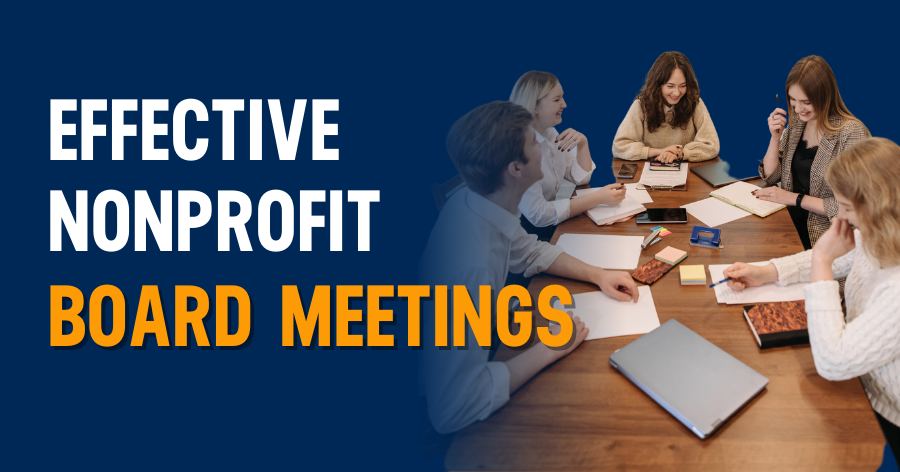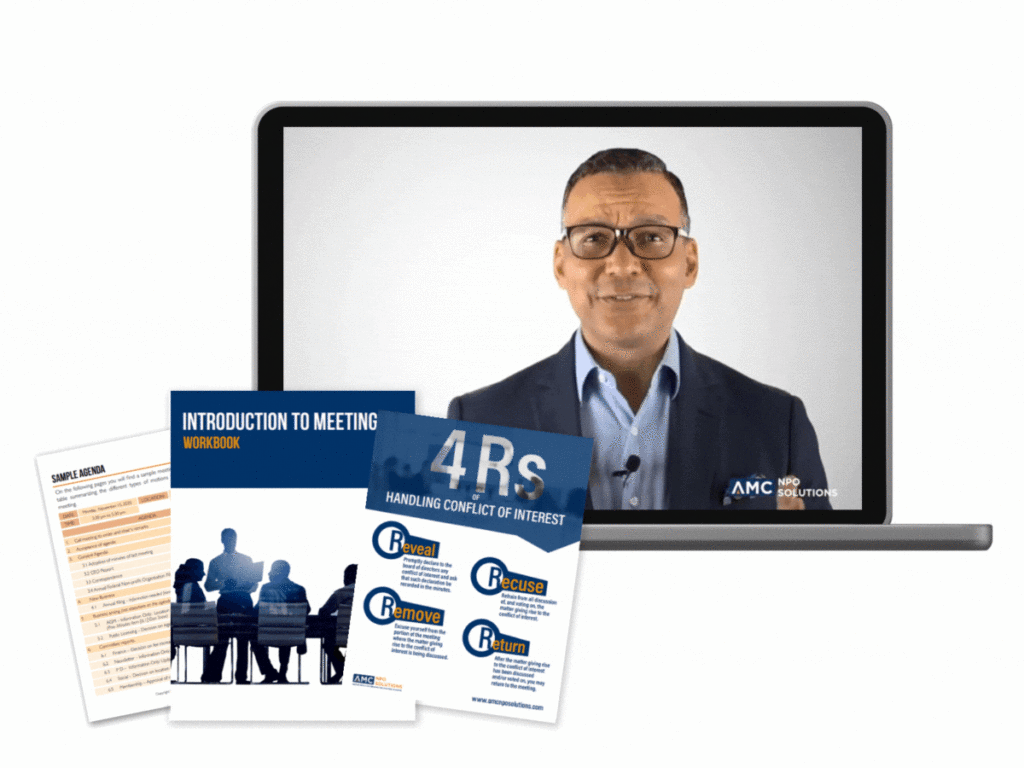
Board meetings should be the most effective way of unleashing your staff’s creative energy, imagination, and hands-on ability. Yet if poorly planned and conducted, a meeting can be the most ineffective, time-wasting, frustrating experience ever inflicted. However, the problem is not the meeting itself. Instead, the problem is often the organizer (Chair) and, often, the participants. So that’s why we’ve put together an 8-step guide for running run effective nonprofit board meetings below to circulate with your board. We hope it helps!
Also read:
- The Role Of The Board Chair At Meetings
- How To Take Board Meeting Minutes: The Nonprofit Guide
- Accommodating People With Disabilities At Meetings and Events
Who is responsible for running a non-profit board meeting?
The nonprofit organization’s leadership, namely the Director and Chair. The Board Chair (or a delegated meeting Chair) mainly ensures that board and membership meetings are productive by undertaking the following tasks, they include:
- Preparing the board meeting agenda
- Confirming that the meeting is called correctly and constituted
- Calling the meeting to order
- Calling for approval of the agenda and any changes
- Conducting the meeting according to the agenda
- Preserving order at the meeting
- Deciding on points of order and procedural issues
- Deciding who properly has the right to speak
- Putting motions to the vote
- Declaring the results of the vote
- Ensuring that the minutes are prepared and distributed
- Setting the time and location of the next meeting
Whereas Directors are required to fulfill responsibilities such as:
- Arriving at the meeting on time
- Preparing for the meeting by reading the pre-circulated materials
- Being respectful of their colleagues and their views
- Debating issues and not personalities
- Knowing how to make and amend motions
- Attending the meeting until it is adjourned
How to run effective nonprofit board meetings
Below are 8 simple rules that will help ensure the success of your productive board meetings. It’s important to note that most of them also apply to other meetings such as committees and task forces:
1. Prepare & circulate the Board Meeting Agenda
First and foremost, you need to ensure that you or the staff distribute the agenda and materials before the meeting. For this reason, this material should include the reports from the committee chairs and the CEO.
A board meeting agenda serves as a roadmap for the Board Chair, whose responsibility is to prepare the agenda; call for approval of the agenda and any changes; conduct the meeting according to the agenda.
When an organization’s Chair has a clear agenda, they can clarify action items and designate who is responsible for addressing them—ultimately helping the board progress in the board meeting and its overall mission.
Nonprofit board meeting agendas are the foundation and framework of every meeting you conduct. They’re a checklist of every topic you want to cover within the board meeting and set the tone for how well you engage participants. Without one, the Chair of the board would have great difficulty:
- Preserving order at the meeting
- Deciding on points of order and procedural issues
- Deciding who has the right to speak
- Putting motions to the vote
- Declaring the results of the vote
For this reason, well-planned and circulated board meeting agendas are crucial for the engagement and productivity of all board members participating.
What should a board meeting agenda include?
While nonprofit board meeting agendas vary significantly in size, content and format, the traditional format almost always includes the following points:
- Welcome
- Call meeting to order and Chair’s remarks
- Acceptance of agenda
- Consent agenda
- Adoption of the minutes of the last meeting
- CEO’s Report
- Financial Report
- Annual federal filing
- Business arising
- Committee reports
- Governance Committee reports
- Audit Committee reports
- Members’ Code of Conduct Task Force
- Other business
- Annual filing
- Date, time, location of next meeting and adjournment
2. Always start & end on time
One of the most significant failings of board chairs is not starting the meeting at the designated time. Subsequently, this approach often sends the wrong message to two groups:
- Those who showed up on time. The message is: “Thank you for arriving on time. But it doesn’t matter because I never start on time.”
- Those who showed up late. The message is: “You didn’t miss anything, and I never start on time.”
For this reason, you should assure participants that you value their time and cooperation by starting every meeting promptly at the time shown on the agenda.
3. Never recap for latecomers
As an effective Chair, you should reward those who arrive on time and encourage those who consistently come late to show respect for their colleagues. If not, you end up recapping what you’ve already dealt with, and this approach sends the following wrong messages to those:
- On-time: “Not only will you have to participate in the meeting as we work through the agenda, but you will have to sit through it all a second time for the benefit of the latecomers.”
- Late: “Don’t bother being on time because I’ll always go over what you missed when you do finally arrive.”
4. Use a Consent Agenda to save time
A consent agenda is a section of the main board meeting agenda that can address routine items that will likely require no discussion. It allows the board to quickly make one motion to “accept, adopt, and receive” several items with a single vote.
How does a consent agenda work?
Before voting on the consent agenda, the Chair can ask whether anyone would like any item removed from the list. If an item is removed from this list, it is transferred to an agreed position in the main board meeting agenda.
However, it’s imperative also to note that a Director does not have to provide any rationale for requesting this move. The remaining items are then dealt with by a single motion to “accept, adopt, and receive the items in the consent agenda.”
Also read: Ultimate Robert’s Rules of Order Cheat-Sheet for Boards
5. Maintain a speakers’ list
While discussing each board meeting agenda item, the Chair should keep a list of the names of the people who have indicated (and in which order) they wish to speak on the matter. This approach enables the Chair to follow the list and call upon each person who has requested time to talk. By following this simple practice, the Chair will help bring fairness and order to the discussion.
6. Allow one speaker at a time
The Chair should always encourage orderly discussion by not allowing cross-talk while any one person is speaking.
7. Take board action meeting minutes
Focusing on well-constructed board meeting minutes helps form a solid foundation for the next board meeting. The organization’s Secretary is officially responsible for recording the minutes at board meetings and will often use Robert’s Rules of Order as a guide or starting point. Yet the chair is also responsible for ensuring the meeting minutes identify what tasks are to be undertaken, by whom, and by what date. By creating an accurate statement of actions that board members took during the meeting, you’re more likely to achieve your goals by the next meeting.
8. State your intentions when chairing a board meeting for the first time
If you’re a new Chair, we recommend that you take a few moments to explain to your colleagues how you intend to chair the group’s meetings when you call your first meeting to order.
Use this opportunity to let them know about the practices that you will follow at meetings. Then explain the purpose to help make sure they effectively use their valuable time. Lastly, ask for their full cooperation so that you can work together to accomplish the board’s mission, goals, and objectives.
Common Nonprofit Board Meeting FAQs
Can nonprofit staff attend board meetings?
Yes, it may be necessary for other people to attend board meetings. For example, you may include the CEO, senior staff, other members, and consultants. However, the chair ultimately decides to invite them and calls on them to speak about issues or answer questions if and when appropriate.
Yet overall attendees must understand that they are under the Chair’s control. As a result, they can’t join discussions but only provide information, though this practice may vary in some organizations. They would not, however, make motions or vote.
Are nonprofit board meeting minutes public?
No. Unless the organization chooses to publish their action minutes, they’re primarily confidential. That’s because the purpose of taking board meeting minutes is to ensure all members, including those not in attendance, are informed about actions and decisions taken. Remember, board meeting minutes are legal documents that can be of use in a court of law.
How often does a nonprofit board have to meet?
An Executive Director or a President often sets the frequency of meetings, but in general, many board nonprofit boards meet on a monthly or quarterly basis. By meeting frequently, you allow members to focus on high-level strategy rather than focusing on the nitty-gritty details. As a result, if you go longer than a quarter without a board meeting, you’ll find it harder to stay on task and achieve meeting goals since much of the discussion will be a recap.
Master the entire process of running nonprofit board meetings
Stop the confusion, conflict and chaos of “bored” meetings.
Our online course makes it fast and easy to train new board members on the dos and don’ts of meetings.
You will learn:
✓ The role and responsibilities of the Chair at meetings
✓ What is expected of the participants at meetings
✓ How to manage the meeting so everything runs smoothly
✓ How to create and follow the meeting agenda
✓ What to include in your meeting minutes
✓ How to avoid conflict of interest at meetings

